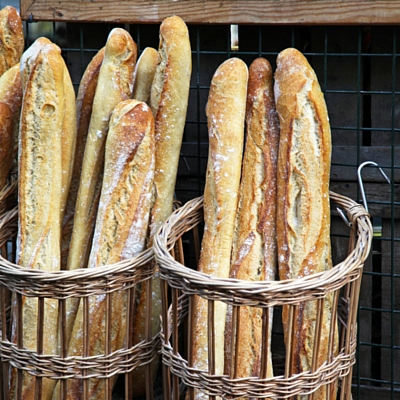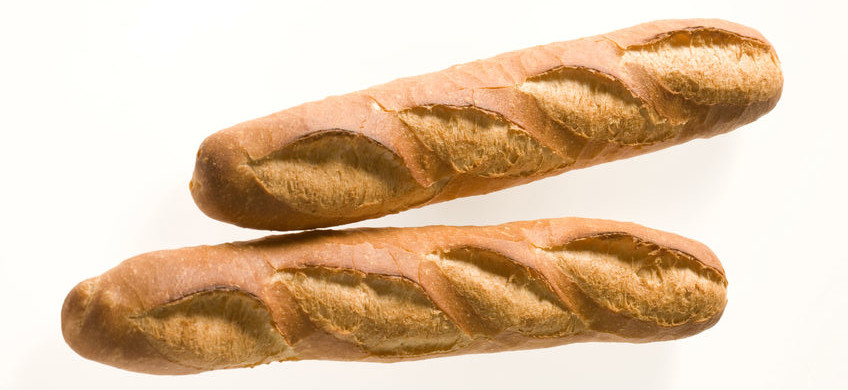Origin
The origins of the baguette are uncertain, but it is generally accepted that it was first made in Vienna as an adaptation of another type of bread. Baguettes then became popular when the French government mandated that bakers not be allowed to work before 4 a.m. making it impossible to make traditional round loaves in time for customers’ breakfast.
Subsequently, bakers had to bake the thinner shaped baguette that would bake faster for the breakfast rush. This switch was also facilitated with the development of new slow yeast fermentation techniques and the availability of new deck ovens which used steam injection Over the years, the baguette became a symbol of France, with a revival in the 1990s.
How are baguettes made?
Traditional French baguettes are normally produced from a relatively lean formula that may or may not contain sugar or shortening. Most French baguette doughs are made with a pre-ferment such as poolish or a sponge which takes up to 10 hours prior to dough making.
A typical baguette formula, using a straight-dough process, looks like this:1,2
| Ingredient | Baker’s % |
| Bread flour | 100 |
| Water | 65–75 |
| Instant active dry yeast (IDY) | 0.8–1.0 |
| Salt | 2 |
| Malt syrup | 0.5 |
| Poolish (optional) | Varies |
Commercial production
Producing a high-quality baguette requires the following steps:2
- Ingredients scaling/metering
- Mixing for 8–12 minutes. Incorporation of dry ingredients and development of gluten. Dough temperature after mixing should be around 25°C (77°F). The poolish may be added at dough mixing.
- Dividing or cutting of pieces from bulk dough to desired unit weight
- Rounding into dough balls
- Intermediate proofing (3–10 minutes)
- Moulding (the dough is shaped into a cylinder)
- Final proofing on hearth bread pans for 60–90 minutes at 27°C (80°F) and 80% humidity
- Scoring (cutting the dough’s top surface)
- Baking in a deck or traveling tray oven at 205–220°C (400–428°F) for 20–30 minutes. Steam baking chamber for first 2–5 minutes
- Removal from oven and cooling for 20 minutes on racks
- Packaging or serving
The weight of a baguette is usually a function of loaf length. The baguettes are usually made up about 46 cm (18 inches) long to produce a 1 pound (454 g) loaf, and 60 cm (24 inches) long to obtain a loaf of about 650–700 g. Baguettes have a high crust to crumb ratio. Therefore, they lose a high percentage of moisture during baking and cooling, and may over bake (dehydrate) easily.
Application
Baguettes are classical products which are characterized by having a hard and crispy crust. A baguette with a soft crust is usually rendered as “stale” and is often rejected by the customer due to poor quality or lack of freshness.
Proper scoring is necessary for product authenticity. Such markings have become part of the traditional character of the baguette. The ‘traditional’ French baguette is given a fixed number of shallow cuts, largely following the length of the dough piece.3 The following is a good illustration of a proper scoring:
Baguette formulations containing no fat may require harder wheats with a higher protein content in the bread flour. This guarantees optimum gas retention properties in the dough. Weaker flours with lower percentages of protein may require the addition of improvers such as oxidizing agents and emulsifiers to improve machinability and add some strength during baking.
Baguette doughs produced on high speed lines or wholesale bakeries must be fully developed during mixing and kneading, and fermented slightly more than normal to withstand the mechanical stress during makeup operations.
Given the high level of hydration and lean formulation of baguettes, a gentle dough handling is required during makeup. Mechanical damage to gas cells during dividing and moulding should be minimized to preserve crumb structure in the finished product.
References
- Suas, M. “Introduction” Advanced Bread and Pastry: A Professional Approach, Delmar Cengage Learning, 2009, pp. 16–17.
- Gisslen, W. “Lean Yeast Doughs: Straight Doughs” Professional Baking, 7th edition, John Wiley & Sons, Inc., 2017, pp. 128–130.
- Cauvain, S.P. “Bread: The Product” Technology of Breadmaking, 3rd edition, Springer International Publishing Switzerland, 2015, pp. 3–19.


